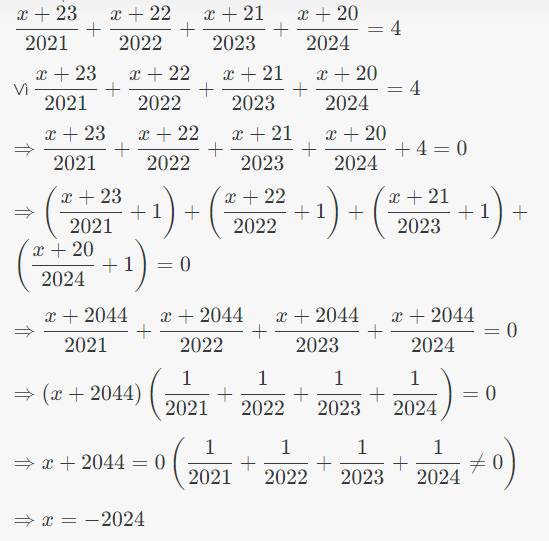Hãy nhập câu hỏi của bạn vào đây, nếu là tài khoản VIP, bạn sẽ được ưu tiên trả lời.

\(\dfrac{x+23}{2021}+\dfrac{x+22}{2022}+\dfrac{x+21}{2023}+\dfrac{x+20}{2024}=-4\)
Vì \(\dfrac{x+23}{2021}+\dfrac{x+22}{2022}+\dfrac{x+21}{2023}+\dfrac{x+20}{2024}=-4\)
\(\Rightarrow\dfrac{x+23}{2021}+\dfrac{x+22}{2022}+\dfrac{x+21}{2023}+\dfrac{x+20}{2024}+4=0\)
\(\Rightarrow\left(\dfrac{x+23}{2021}+1\right)+\left(\dfrac{x+22}{2022}+1\right)+\left(\dfrac{x+21}{2023}+1\right)+\left(\dfrac{x+20}{2024}+1\right)=0\)
\(\Rightarrow\dfrac{x+2044}{2021}+\dfrac{x+2044}{2022}+\dfrac{x+2044}{2023}+\dfrac{x+2044}{2024}=0\)
\(\Rightarrow\left(x+2044\right)\left(\dfrac{1}{2021}+\dfrac{1}{2022}+\dfrac{1}{2023}+\dfrac{1}{2024}\right)=0\)
\(\Rightarrow x+2044=0\left(\dfrac{1}{2021}+\dfrac{1}{2022}+\dfrac{1}{2023}+\dfrac{1}{2024}\ne0\right)\)
\(\Rightarrow x=-2024\)

\(\left(x-2022\right)^{2024}+\left|y-2023\right|\le0\left(1\right)\)
Nhận thấy : \(\left(x-2022\right)^{2024}\ge0\forall x\inℝ,\left|y-2023\right|\ge0\forall y\inℝ\)
\(=>\left(x-2022\right)^{2024}+\left|y-2023\right|\ge0\forall x,y\inℝ\)
Do đó (1) xảy ra khi :
\(\left(x-2022\right)^{2024}=0,\left|y-2023\right|=0\)
\(=>\left(x;y\right)=\left(2022;2023\right)\)


Áp dụng tính chất của dãy tỉ số bằng nhau,ta có:
\(\dfrac{x}{y}=\dfrac{y}{z}=\dfrac{z}{x}=\dfrac{x+y+z}{y+z+x}=\dfrac{x+y+z}{x+y+z}=1\)
\(\Rightarrow\left\{{}\begin{matrix}x=y\\y=z\\z=x\end{matrix}\right.\)
Do đó \(\left\{{}\begin{matrix}x-y=0\\y-z=0\\z-x=0\end{matrix}\right.\)
Thay vào biểu thức \(P=\left(x-y\right)^{2022}+\left(y-z\right)^{2023}+\left(x-z-1\right)^{202}\),ta có:
\(P=0^{2022}+0^{2023}+\left(-1\right)^{202}\)
\(=0+0+1\)
\(=1\)
So sánh
A = \(\dfrac{2022^{2023}+1}{2022^{2024}+1}\) và B = \(\dfrac{2022^{2022}+1}{2022^{2023}+1}\)

Trước hết ta phải chứng minh \(\dfrac{a}{b}< \dfrac{a+1}{b+1}\) (a, b ϵ N; a < b).
Thật vậy, \(\dfrac{a}{b}=\dfrac{a\left(b+1\right)}{b\left(b+1\right)}=\dfrac{a+ab}{b^2+b}\) và \(\dfrac{a+1}{b+1}=\dfrac{\left(a+1\right)b}{\left(b+1\right)b}=\dfrac{ab+b}{b^2+b}\).
Mà theo giả thuyết là a < b nên \(\dfrac{a+ab}{b^2+b}< \dfrac{ab+b}{b^2+b}\), suy ra \(\dfrac{a}{b}< \dfrac{a+1}{b+1}\) (a, b ϵ N; a < b).
Từ đây ta có:
\(B=\dfrac{2022^{2022}+1}{2022^{2023}+1}=\dfrac{2022^{2023}+2022}{2022^{2024}+2022}=\dfrac{2022^{2023}+2021+1}{2022^{2024}+2021+1}\)
Đặt \(A_1=\dfrac{2022^{2023}+2}{2022^{2024}+2}=\dfrac{2022^{2023}+1+1}{2022^{2024}+1+1}\), rõ ràng \(A_1>A\).
Đặt \(A_2=\dfrac{2022^{2023}+3}{2022^{2024}+3}=\dfrac{2022^{2023}+2+1}{2022^{2024}+2+1}\), rõ ràng \(A_2>A_1\).
...
Đặt \(A_{2020}=\dfrac{2022^{2023}+2021}{2022^{2024}+2021}=\dfrac{2022^{2023}+2020+1}{2022^{2024}+2020+1}\), rõ ràng \(A_{2020}>A_{2019}\) và \(B>A_{2020}\).
Suy ra \(B>A_{2020}>A_{2019}>...>A_2>A_1>A\). Vậy A < B.
Ta có A = \(\dfrac{2022^{2023}}{2022^{2024}}=\dfrac{1}{2022}\) ; B = \(\dfrac{2022^{2022}}{2022^{2023}}=\dfrac{1}{2022}\)
Mà \(\dfrac{1}{2022}=\dfrac{1}{2022}\)
Vậy A = B

Ta có: \(\left|x\right|>=0\forall x\)
=>\(\left|x\right|+2023>=2023\forall x\)
=>\(\dfrac{2022}{\left|x\right|+2023}< =\dfrac{2022}{2023}\forall x\)
=>\(A< =\dfrac{2022}{2023}\forall x\)
Dấu '=' xảy ra khi |x|=0
=>x=0
Vậy: \(A_{max}=\dfrac{2022}{2023}\) khi x=0
\(A=\dfrac{2022}{\left|x\right|+2023}\)
Ta thấy: \(\left|x\right|\ge0\forall x\)
\(\Rightarrow\left|x\right|+2023\ge2023\forall x\)
\(\Rightarrow\dfrac{1}{\left|x\right|+2023}\le\dfrac{1}{2023}\forall x\)
\(\Rightarrow A=\dfrac{2022}{\left|x\right|+2023}\le\dfrac{2022}{2023}\forall x\)
Dấu \("="\) xảy ra khi: \(x=0\)
Vậy \(Max_A=\dfrac{2022}{2023}\) khi \(x=0\).

olm sẽ hướng dẫn em làm bài này như sau:
Bước 1: em giải phương trình tìm; \(x\); y
Bước 2: thay\(x;y\) vào P
(\(x-1\))2022 + |y + 1| = 0
Vì (\(x-1\))2022 ≥ 0 ∀ \(x\); |y + 1| ≥ 0 ∀ y
⇒ (\(x\) - 1)2022 + |y + 1| = 0
⇔ \(\left\{{}\begin{matrix}\left(x-1\right)^{2022}=0\\y+1=0\end{matrix}\right.\)
⇒ \(\left\{{}\begin{matrix}x=1\\y=-1\end{matrix}\right.\) (1)
Thay (1) vào P ta có:
12023.(-1)2022 : )(2.1- 1)2022 + 2023
= 1 + 2023
= 2024
